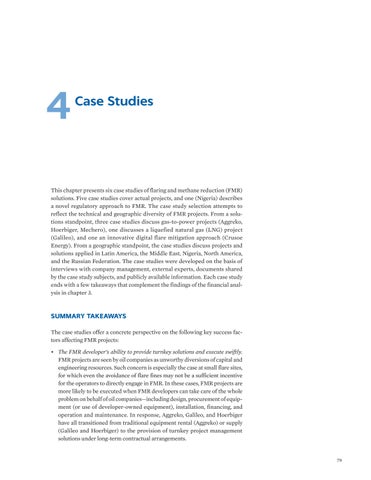4
Case Studies
This chapter presents six case studies of flaring and methane reduction (FMR) solutions. Five case studies cover actual projects, and one (Nigeria) describes a novel regulatory approach to FMR. The case study selection attempts to reflect the technical and geographic diversity of FMR projects. From a solutions standpoint, three case studies discuss gas-to-power projects (Aggreko, Hoerbiger, Mechero), one discusses a liquefied natural gas (LNG) project (Galileo), and one an innovative digital flare mitigation approach (Crusoe Energy). From a geographic standpoint, the case studies discuss projects and solutions applied in Latin America, the Middle East, Nigeria, North America, and the Russian Federation. The case studies were developed on the basis of interviews with company management, external experts, documents shared by the case study subjects, and publicly available information. Each case study ends with a few takeaways that complement the findings of the financial analysis in chapter 3.
SUMMARY TAKEAWAYS The case studies offer a concrete perspective on the following key success factors affecting FMR projects: • The FMR developer’s ability to provide turnkey solutions and execute swiftly. FMR projects are seen by oil companies as unworthy diversions of capital and engineering resources. Such concern is especially the case at small flare sites, for which even the avoidance of flare fines may not be a sufficient incentive for the operators to directly engage in FMR. In these cases, FMR projects are more likely to be executed when FMR developers can take care of the whole problem on behalf of oil companies—including design, procurement of equipment (or use of developer-owned equipment), installation, financing, and operation and maintenance. In response, Aggreko, Galileo, and Hoerbiger have all transitioned from traditional equipment rental (Aggreko) or supply (Galileo and Hoerbiger) to the provision of turnkey project management solutions under long-term contractual arrangements.
79


